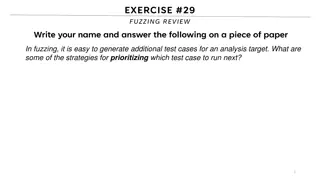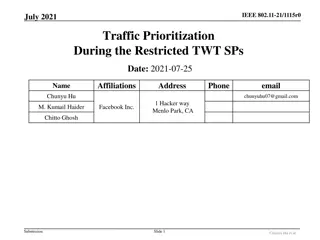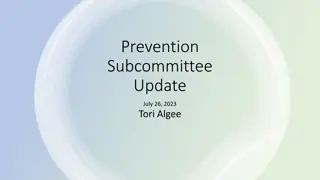Strategic Planning for Health Security - Prioritization and Assessment Review
This presentation template focuses on compiling and reviewing reference data, reviewing previous National Action Plan for Health Security (NAPHS) implementation progress, and summarizing recommendations from recent assessments. It provides a structured approach to identify potential actions, inform prioritization, and make strategic decisions based on assessment findings.
Uploaded on Sep 19, 2024 | 3 Views
Download Presentation

Please find below an Image/Link to download the presentation.
The content on the website is provided AS IS for your information and personal use only. It may not be sold, licensed, or shared on other websites without obtaining consent from the author.If you encounter any issues during the download, it is possible that the publisher has removed the file from their server.
You are allowed to download the files provided on this website for personal or commercial use, subject to the condition that they are used lawfully. All files are the property of their respective owners.
The content on the website is provided AS IS for your information and personal use only. It may not be sold, licensed, or shared on other websites without obtaining consent from the author.
E N D
Presentation Transcript
Prioritization template Slide 2. Template Slide 10. Example
Enter Technical Area National Action Plan for Health Security (NAPHS) | Strategic Planning Enter author information
Steps 1-3. Compile and review reference data Compile implementation, assessment, and WHO Benchmarks data to identify potential actions and inform their prioritization.
About this slide If available, transfer data from the previous cycle (5-year strategic plan implementation) from the routine implementation tracker. 1. Review previous NAPHS implementation progress Enter Technical Area Indicator Objective Strategic action % Completion Challenges Lessons or best practices Recommendations Enter max 3, if applicable Enter max 3, if applicable Enter max 3, if applicable # # Enter strategic action #% Enter max 3, if applicable Enter max 3, if applicable Enter max 3, if applicable # # Enter strategic action #% Enter max 3, if applicable Enter max 3, if applicable Enter max 3, if applicable # # Enter strategic action #% Enter max 3, if applicable Enter max 3, if applicable Enter max 3, if applicable # # Enter strategic action #% Add or delete rows, or duplicate this slide as necessary. Add or delete rows, or duplicate this slide as necessary. Add or delete rows, or duplicate this slide as necessary. Add or delete rows, or duplicate this slide as necessary. # # #%
2. Review recommendations from assessments Enter Technical Area About this slide Summarize data from recent (1-2 years) or latest available assessments. Countries with JEE scores more than 3 years old should use their latest SPAR scores. Recommendations Referenced IHR assessment Risks or events evaluated Choose relevant assessment: Functional exercise (IAR/AAR/SimEx) Risk assessment (STAR/VRAM) 7-1-7 Results Other assessment List risks or events evaluated Briefly summarize recommendation Choose relevant assessment: Functional exercise (IAR/AAR/SimEx) Risk assessment (STAR/VRAM) 7-1-7 Results Other assessment Briefly summarize recommendation List risks or events evaluated Choose relevant assessment: Functional exercise (IAR/AAR/SimEx) Risk assessment (STAR/VRAM) 7-1-7 Results Other assessment Briefly summarize recommendation List risks or events evaluated Choose relevant assessment: Functional exercise (IAR/AAR/SimEx) Risk assessment (STAR/VRAM) 7-1-7 Results Other assessment Briefly summarize recommendation List risks or events evaluated Add or delete rows, or duplicate this slide as necessary. Add or delete rows, or duplicate this slide as necessary. Add or delete rows, or duplicate this slide as necessary.
3. Review benchmark actions to achieve target JEE/SPAR scores Enter Technical Area About this slide Reference actions required to reach goal scores using the Benchmarks digital tool. Indicator Most recent JEE or SPAR score Target score (end of year) Actions required to achieve target score for next year Choose relevant level: 1 No capacity 2 Limited capacity 3 Developed capacity 4 Demonstrated capacity 5 Sustainable capacity Choose relevant level: 1 No capacity 2 Limited capacity 3 Developed capacity 4 Demonstrated capacity 5 Sustainable capacity Reference benchmark actions recommended in WHO Benchmarks for IHR Capacities Enter indicator Choose relevant level: 1 No capacity 2 Limited capacity 3 Developed capacity 4 Demonstrated capacity 5 Sustainable capacity Choose relevant level: 1 No capacity 2 Limited capacity 3 Developed capacity 4 Demonstrated capacity 5 Sustainable capacity Reference benchmark actions recommended in WHO Benchmarks for IHR Capacities Enter indicator Choose relevant level: 1 No capacity 2 Limited capacity 3 Developed capacity 4 Demonstrated capacity 5 Sustainable capacity Choose relevant level: 1 No capacity 2 Limited capacity 3 Developed capacity 4 Demonstrated capacity 5 Sustainable capacity Reference benchmark actions recommended in WHO Benchmarks for IHR Capacities Enter indicator Add or delete rows, or duplicate this slide as necessary. Add or delete rows, or duplicate this slide as necessary. Add or delete rows, or duplicate this slide as necessary. Add or delete rows, or duplicate this slide as necessary.
Steps 4-5. Prioritize strategic actions Reference the previous slides to guide discussions and consensus building to select 2-3 actions to prioritize.
About this slide Based on slides 2-4, assess the impact and feasibility of actions. Use this matrix to guide discussions and consensus building to select 2-3 actions (per year of implementation) to prioritize. 4. Identify potential actions then prioritize Enter Technical Area Impact Feasibility Based on steps 1-3, discuss technical, financial, and political considerations to assign a level. Strategic action Based on steps 2 4 identify updated or added actions that may be prioritized. Based on steps 1-3, discuss how the action might impact the strengthening of IHR capacities and addressing gaps to assign a level. Prioritization category Use the matrix (right) to assign a category. Impact-feasibility matrix High impact B A Enter strategic action (potential actions were recommended in steps 2-4) Choose relevant level: High Low Choose relevant level: High Low Choose priority level: A, B, C. D Major Low-hanging fruit (high-high) consider prioritizing projects (high-low) consider prioritizing Low High feasibility feasibility D C Thankless tasks (low-low) consider eliminating Enter strategic action (potential actions were recommended in steps 2-4) Choose relevant level: High Low Choose relevant level: High Low Fill-ins (low-high) consider eliminating Choose priority level: A, B, C. D Low impact Add more rows or duplicate this slide if necessary (e.g., multiple years) Add more rows or duplicate this slide if necessary (e.g., multiple years) Add more rows or duplicate this slide if necessary (e.g., multiple years) Add more rows or duplicate this slide if necessary (e.g., multiple years)
5. Finalize actions then draft activities Enter Technical Area About this slide Complete this draft slide then align with other technical areas to consolidate an multi-sectoral strategic plan. Present this slide. Year of planned implementation Responsible Focal Point (Project manager) Prioritized strategic actions Detailed NAPHS activities Enter detail activity 20XX Enter name, affiliation, email 1 Enter detail activity 20XX Enter name, affiliation, email 2 Enter strategic action 1 Enter detail activity 20XX Enter name, affiliation, email 3 Add more rows or duplicate this slide if necessary. Add more rows or duplicate this slide if necessary. 20XX # Enter detail activity 20XX Enter name, affiliation, email 1 Enter detail activity 20XX Enter name, affiliation, email 2 Enter strategic action 2 Enter detail activity 20XX Enter name, affiliation, email 3 Add more rows or duplicate this slide if necessary. Add more rows or duplicate this slide if necessary. 20XX # Recommendation: limit to 2-3 strategic actions per year only























